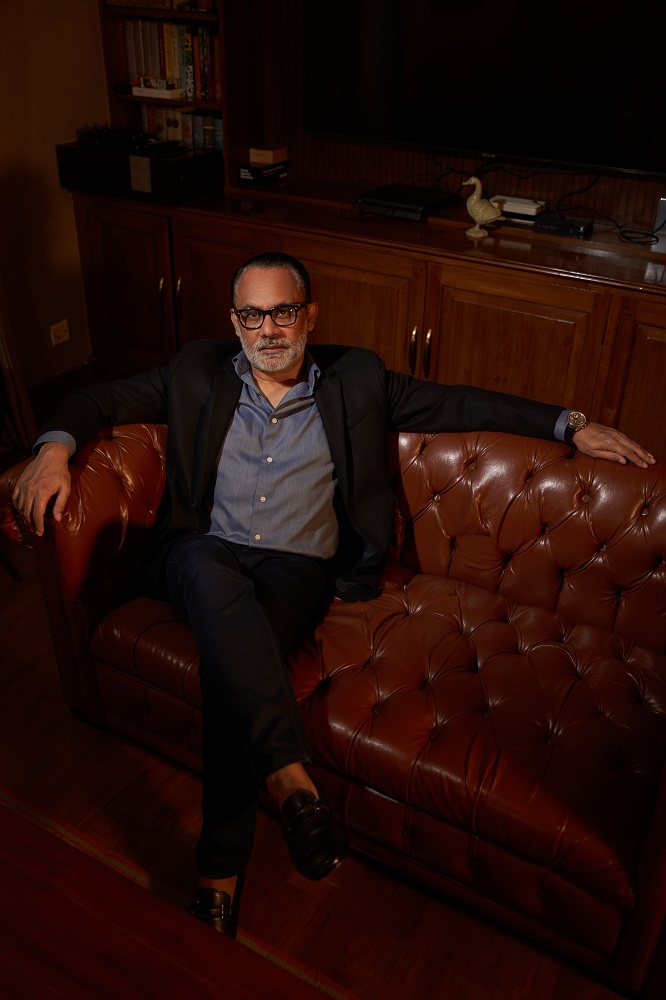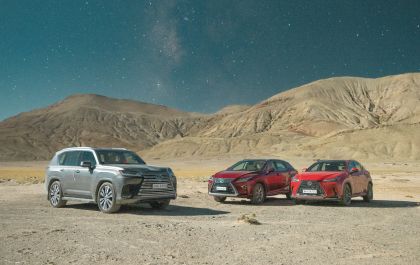Rezwan Rahman is an art curator and a director of Special Olympics Bangladesh. The IT professional (he is the Chairman of Tradexcel Ltd) has curated several exhibitions, and is also involved in raising awareness and funds for the special athletes of Bangladesh, who have achieved remarkable success in international events. With the 9+One: Interdimensional Journeys exhibition running at Edge Gallery, he got on a phone call with MWB to talk all things art
By Sabrina Fatma Ahmad
A line of life-size painted ants crawl from the floor, up the wall and onto the giant canvas, circling around the giant golden apples on one large canvas, appearing again on a smaller painting next to it, before finally finding a green apple on a third painting at the bottom. The interplay between the paintings from Nargis Poly’s Midas series, and the use of the display space at the Edge Gallery evokes a narrative that invites the viewer into a conversation about class and capitalism. As one prowls through the exhibition space, one is met with lithographs, prints, and mixed media paintings in muted tones and soothing blue-green palettes, with a sudden burst of fuchsia and neon pink functioning like an exclamation point, and the open spaces are punctuated by sculptural pieces. 9+One promises an interdimensional journey, and delivers in spades.
Tell us a little bit about your curation process
An exhibition is supposed to elicit a response from the viewer, and the curator’s job is to use the display space to craft a dialogue through the arrangement of the pieces and/or the design elements, according to the planned theme of the event. The focus of 9+One was to see how emerging Bangladeshi artists express their thoughts about the world around them, the issues that they are concerned with, and the language of their self-expression. After making the final selection, we had to distil the themes that emerged and then design the space to best reflect these themes. Everything, from how the pieces are positioned within the space, to additional elements and lighting, has to work in service of giving the viewer an intimation about the themes.
What were your criteria for the selection?
We were looking for young voices; bold and uncompromising in their self-expression. Not only did I want the dynamism and fresh perspective of these unfettered imagination, I was looking for work that challenged existing stereotypes and pushed the envelope in terms of artistic styles. No subject was taboo for them.
Some of the pieces you see aren’t necessarily aesthetically pleasing, but carry a strong social message, such as Farzana Ahmed Urmi’s work on the women in Rohingya camps, or Soma Surovi Jannat’s sketches. Others seem pretty enough at first glance until you look closer and they reveal a disturbing truth, like Auntora Mehrukh Azad’s neon series about climate change.
And then there are artists that made some bold social commentary, like Rasel Rana, who incorporated his views about gender inclusivity into his vibrant, colorful landscapes.

What were you hoping to find, and did you find it?
I wanted to see what comes out before the artist becomes beholden to a style or mode that they think defines them. History’s greats were always evolving; think about (Pablo) Picasso – he went through several ‘periods’ – his Blue period, his Cubism, just to name a few. Unfortunately, the environment here is such that most of the artists here – I’m not talking about our living legends – when they find success with one thing, they stick to that and stop stepping out of their comfort zone.
Did I find what I was looking for? I think so. We had some refreshing experimentations with media. For example, there was Najmun Nahar Keya, who took the Japanese principle of kintsugi, which is the art of mending broken crockery with gold to celebrate the beauty of imperfections, and applied gold paint to old paintings of Dhaka – as a way of reconciling with her past. That was really different. There were many such experimentations.
An exhibition is naturally a collaborative process. What were the challenges of this collaboration?
The biggest challenge was selecting the artists who made the cut. We had so many talented candidates, such an immensely rich volume of work, that it was impossible to accommodate everyone. It was rather heartbreaking, really, to have to leave out some of the work, but ultimately that’s what we had to do to sharpen the focus and create a cohesive exhibition. I hope to in the future be able to showcase the artists who were left out this time.
As far as the gallery was concerned, there were no challenges. I consider myself fortunate to have been granted full creative freedom, because this isn’t something you can take for granted, so that was a very comfortable aspect.
So how do you balance personal taste with the vision of the exhibition?
I never compromise with the vision and theme of the exhibitions, but I will say this – the piece has to speak to me, to provoke an emotion or an intellectual response, to feel right, otherwise it’s not going in.
And what kind of art do you personally gravitate towards?
I’m personally more interested in abstract art – like Rothko or Kiefer. I think our (Mohammad) Kibria is one of the greatest artists produced by this sub-continent. I prefer the art to create room for the viewer to glean their own interpretations. Of course, all great artists do that to some extent – if you consider the musculature of SM Sultan’s subjects, and how they were meant to denote the strength of our farmers, not in terms of literal physicality, but some inner strength, or Zainul Abedin’s work on the famine.
But when the image or installation in front of you doesn’t give you the interpretation right away and reaches you in some subliminal space, it is an invitation for you to bring your own meaning to the piece. I love that.

Can we dial back the clock a bit and talk about how you got into collecting art in the first place?
I’ve always been interested in art. I travel extensively and whenever I do, I make some time to visit the museums and galleries and see what’s happening there. But I guess, to answer your question, I remember buying a piece for my home back in 2001. I liked how it looked on my wall, so I added another, and it changed the space, and then I added another, and so on until I ran out of wall space and realized that maybe I have something close to an obsession. [Laughs]
I enjoyed interacting with the art, seeing how grouping certain pieces can enhance or affect how one sees them, and wanted to explore combinations in different spaces, and so I began to curate exhibitions. I haven’t looked back since.
Let’s go on a tangent now and talk about the Special Olympics Bangladesh, of which you are the director. You curated a charity art auction in 2019 to raise awareness for the differently abled. Do you want to tell us a little bit about that?
Ah yes. The first thing I want to say is that what most people don’t know is that the Special Olympics are a global event comparable in scale to the “regular” Olympics, and Bangladesh actually has been performing extraordinarily. We won 24 gold medals in this year, but it didn’t get much press, which is a shame, so of course, I want to raise more awareness about that. I organized the auction in 2019, with plans to do more, but the pandemic put the brakes on that. Hopefully now that things have opened up, I can revisit those plans.
In 2019, Rezwan Rahman, as Director of Special Olympics Bangladesh curated a (live and silent) art auction at Edge Gallery to raise awareness and funds for special athletes. Featured artists comprised of Shahabuddin Ahmed, Rafiqun Nabi, Monirul Islam, Kanak Chanpa Chakma, Muhammad Iqbal, Hamiduzzaman Khan, Maksuda Iqbal Nipa, Mohammad Eunus, Mahmudul Huque, Abdus Shakoor Shah, Rokeya Sultana, Jamal Ahmed, Abul Bark Alvi, Nisar Hossain, Samarjit Roy Chowdhury, Vinita Karim, Tejosh Halder, Shahid Kabir, Shishir Bhattacharjee, Tajuddin Ahmed, Tayeba Begum Lilpi, Jogen Chowdhury, Tapas Konar, and Samir Aich.
Wow, that’s a whole conversation in and of itself, one which we hope to revisit soon. For now, let’s end with what you hope to see in the Bangladeshi art scene in the next five years?
Hopefully, growth. I want to see artists push their boundaries, break the taboos, stop playing safe, and really explore their possibilities. I hope that we can foster the right environment for them to be able to do this as well. When you keep playing to the tune of what you think your audience expects of you, you can get typecast very easily, and unfortunately, there is a strong tendency for that to happen. But I have seen the talent that’s out there, and I have great hopes for them.














